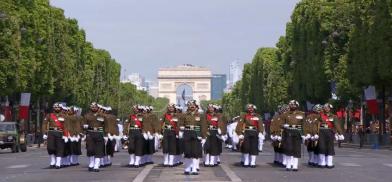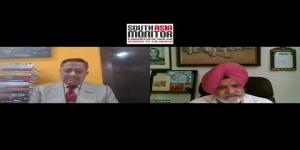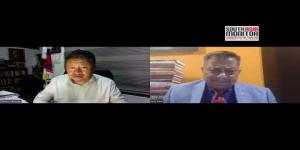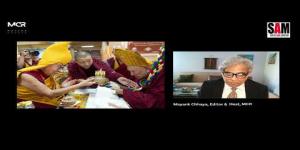Bastille Day marked the high point of burgeoning India-France strategic ties
It was after India’s second nuclear test in May 1998 that the India-France relationship warmed up. One major catalyst for this was that at a time when many nations were judgemental about India’s test, France’s stand was that it was India’s prerogative to conduct such a test based on the threats it faced.

Bastille Day, France’s national day, on July 14, 2023, was marked by a major Indian presence of Prime Minister Narendra Modi and 269 military personnel, who participated in the impressive parade which passed down the Avenue des Champs-Élysées from Place Charles de Gaulle, centred around the Arc de Triomphe, to the Place de la Concorde, where President Emmanuel Macron stood with PM Modi, important members of the government and the diplomatic corps.
Of the 269 Indian military personnel at the Bastille Day parade, Indian Army was represented by the Punjab Regiment contingent, led by Capt Aman Jagtap. One of its oldest regiments which participated in both the World Wars as well as India’s post-independence operations in World War-I, the Punjab Regiment was awarded 18 Battle and Theatre Honours. The gallant soldiers fought in Mesopotamia, Gallipoli, Palestine, Egypt, China, Hongkong, Damascus and France. In France, they took part in an offensive near Neuve Chapelle in September 1915, earning the Battle Honours 'Loos' and ‘France and Flanders’. In World War II, they were awarded 16 Battle Honours and 14 Theatre Honours. The band was of Rajputana Rifles, the seniormost rifle regiment of the Indian Army. Most of its battalions have a long and glorious history including some of the bloodiest battles in many theatres of the world and exemplary contribution in both the World Wars, as well as in India's various post-Independence conflicts.
The Indian Navy team on parade comprised four officers and 64 sailors led by Commander Vrat Baghel. The Indian Air Force (IAF) contingent of 72 personnel included four Rafale fighters, two C-17 Globemasters. The flypast and marching by the Indian Air Force air warriors on Bastille Day follows a long association that the two nations share in air power. Many Indians like Welinkar, Shivdev Singh, HC Dewan and Jumbo Majumdar fought over the skies of France during both World Wars. Some, like Jumbo Majumdar, were also decorated for their gallant action over the Falaise Gap during the terminal phase of World War II. The IAF has also operated multiple French aircraft starting with the Ouragan, followed by fighter aircraft like Breguet Alize, Mystere IVA, SEPECAT Jaguar, Mirage 2000 and now, the Rafale. Helicopters like the Alouette-III and Lama continue to be flown by aviators of all three services, especially in the remote Himalayan areas. The IAF marching contingent at the parade was commanded by a woman officer, Squadron Leader Sindhu Reddy, an accomplished helicopter pilot.
Ties have a long history
The India-France relationship is one worth taking a long look at. While a substantial post-Independence part of this relationship covers strategic-military cooperation, there are strong cultural bonds that were formed in the pre-colonial era till the World Wars period. There are some interesting vignettes of the early periods of the India-France relationship.
In 1674, the French East India Company set up a trading centre at Pondicherry, which eventually became the chief French settlement in India. On 9 June 1952, the Government of India took control of Chandernagore, which later in 1954 became part of the Hooghly district of West Bengal. In May 1956, a treaty of cession was signed by India and France which was ratified by the French parliament in May 1962. On 16 August 1962 India and France exchanged the instruments of ratification under which France ceded to India full sovereignty over the territories it held. Pondicherry and the other enclaves of Karaikal, Mahe and Yanam came to be administered as the Union Territory of Puducherry from 1 July 1963.
In the 18th and 19th centuries a number of Indian rulers requisitioned French soldiers to join their armies to fight the British East India Company. Jean-Francois Allard was a highly trusted general of Maharaja Ranjit Singh, who modernised his army and formed the Fauj-i-Khas (special brigade), which in 1826 comprised 10,000 men, into 3 cavalry regiments, 4 infantry regiments and one unit of modern artillery. In 1827, 15,000 men were under Allard’s command. In Saint Tropez, where Allard hailed from, a statute of Maharaja Ranjit Singh was installed in October 2016, by its mayor, Henri Prevost-Allard, a descendant of Allard.
In World War I (1914-18) after the French got over their long-standing enmity against the British and fought together as Allies against the Germans. It was in that war that the French expressed their heartfelt gratitude to many of the 1.5 million Indian troops whose arrival and participation turned the tide of the German onslaught against France. Marshal Ferdinand Foch, the French Commander at the Battle of Neuve Chapelle (10-13 March 1915), in which 4,200 Indian soldiers died, acknowledged the contribution of Indian troops saying: "Return to your homes in the distant, sun-bathed East and proclaim how your countrymen drenched with their blood the cold northern land of France and Flanders, how they delivered it by their ardent spirit from the firm grip of a determined enemy; tell all India that we shall watch over their graves with the devotion due to all our dead. We shall cherish above all the memory of their example. They showed us the way, they made the first steps towards the final victory”.
In World War II, 2.5 million Indian Army, Navy and Air Force personnel participated in all theatres. Again, the French people and soldiers, who fought alongside Indian troops, praised their role, which again was a major war-winning factor.
Growth of a strategic partnership
Post-World War II, when the British and the Americans continued to pursue wartime information censorship on nuclear energy and India was trying to acquire nuclear technology, it was the French who responded. Frédéric Joliot-Curie, then chairman of the French Atomic Energy Commission (CEA), visited India in January 1950 and made offers for technical cooperation that were not just extraordinary but also unprecedented. It initiated negotiations for the first bilateral nuclear cooperation agreement outside the Manhattan Project. At a special meeting of the Indian Atomic Energy Commission (AEC) held in New Delhi on January 17, 1950, Joliot-Curie offered to share technical information on the purification of uranium, graphite reprocessing, and designs of a low-power reactor in exchange for India’s export to France of thorium, beryllium, and uranium, among others.
Such an offer was unthinkable at a time when the US was keen on maintaining an embargo over nuclear technology transfer and knowhow while the UK and Canada adhered to a similar approach.
It was after India’s second nuclear test in May 1998 that the India-France relationship warmed up. One major catalyst for this was that at a time when many nations were judgemental about India’s test, France’s stand was that it was India’s prerogative to conduct such a test based on the threats it faced.
With both India and France supporting a multipolar world led by democracies, what emerged was that France had been a constant supporter of India’s claims to permanent membership in the United Nations Security Council (UNSC). France had also been a great supporter of India for membership to all four multilateral export control regimes, namely the Wassenaar Arrangement (WA), the Nuclear Suppliers Group (NSG), the Missile Technology Control Regime (MTCR), and the Australia Group (AG). France’s support was instrumental in India’s accession to the WA, MTCR and AG. Also, both nations are strongly in the war against global terror.
In 1998, the relationship between India and France took a new turn, when both nations entered into a strategic partnership based on military, space and civil nuclear cooperation.
Tech and defence partner
PM Modi’s first visit to France in April 2015 highlighted New Delhi’s expanding ties with Paris and underlined India’s attempts to diversify its defence purchases. It also re-emphasised the congruence that existed between the two countries during most of the Cold War. France gradually emerged as a formidable technology supplier to India in all three strategic realms - military, space and nuclear energy. India’s vast market and its appetite for advanced strategic technology make it rather attractive to France.
In May 2022, PM Modi again visited France during which both countries signed a number of MoUs and issued joint statements reflecting the deepening cooperation between the two countries. In March 2018, French President Emmanuel Macron visited India during which 14 business-to-business agreements were signed. France is the only country to be invited five times to the Republic Day Parade in India as a chief guest. This is the highest for any country.
Regular talks take place between the service chiefs of both nations. An annual defence dialogue at the ministerial level has also been initiated in 2018. Besides the regular military exercises between France and India, codenamed Shakti (Army), Varuna (Navy) and Garuda (Air Force), there are many others which are conducted from time to time.
India has been buying defence equipment from France, the most famous of them being Rafale aircraft and P-75 Scorpene project. The contract for six Scorpene submarines from M/s DCNS was signed in October 2006. There is a Dassault Reliance Aerospace Limited (DRAL) manufacturing facility at Mihan in Maharashtra, which is a joint venture between India’s Reliance Group and the French aerospace company Dassault Aviation. On July 14, 2023, the Indian Government announced the selection of the maritime Rafale to equip the Indian Navy with the latest-generation fighter. The Indian Navy's 26 Rafale will eventually join the 36 Rafale already in service. The Bastille Day visit also resulted in three Scorpene submarines and sixteen more Rafales being added.
Space and civil nuclear cooperation
India and France have been cooperating in the space domain for many years now. ISRO and CNES (the French space agency) have conducted joint research programmes and satellite launches. Examples of joint Indo-French satellites: TRISHNA, Megha-Tropiques, etc. France is a major supplier of equipment and components for the Indian space programme.
Civilian nuclear cooperation constitutes one of the cornerstones of the Indo-French strategic partnership. The cooperation agreement of 30 September 2008 between India and France on the development of nuclear energy for peaceful purposes, sets the framework of exchanges with India not only at the industrial and commercial levels but also in R&D, nuclear safety, and education/training.
On the industrial front, AREVA, which in 2008 sold 300 tons of nuclear fuel to the public electricity utility Nuclear Power Corporation of India Limited, submitted a tender for two EPR reactors (2 x 1650 MWe capacity) for the Jaitapur site, along with their fuel supply. Eventually, the site is due to house four other similar reactors (10,000 MWe capacity). Regarding R&D, various bilateral agreements provide for exchanges between French organisations (CEA, ANDRA) and Indian ones (DAE, IGCAR, BARC, HBNI) in the fields of reactor safety/security, basic research, radioactive waste management, non-electrical applications of nuclear energy. Cooperation in Education/Training includes a master’s degree in Nuclear Energy. Further, exchanges have been established between the nuclear safety authorities of the two countries and their technical supports.
On the multilateral front, India is participating in major international R&D projects: Jules Horowitz Reactor (nuclear fission) and ITER (thermonuclear fusion).
While India-France cooperation has always been an irritant to China, the level to which it has reached by Bastille Day, 2023, has rattled China, even more so as it followed PM Modi’s visit to the US.
(The author, a strategic analyst, is a former spokesperson of the Defence Ministry and Indian Army. Views are personal. He can be contacted at wordsword02@gmail.com)










Post a Comment